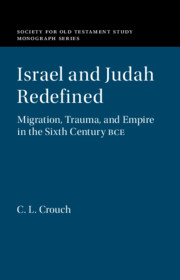Book contents
- Israel and Judah Redefined
- Society for Old Testament Study
- Israel and Judah Redefined
- Copyright page
- Dedication
- Contents
- Acknowledgements
- Abbreviations
- Introduction
- Part I
- Part II
- 2 Israel in Jerusalem
- 3 Israel in Rural Babylonia
- 4 Israel in Urban Babylon
- Part III
- Bibliography
- Biblical Texts Index
- Modern Authors Index
- Subject Index
3 - Israel in Rural Babylonia
from Part II
Published online by Cambridge University Press: 05 August 2021
- Israel and Judah Redefined
- Society for Old Testament Study
- Israel and Judah Redefined
- Copyright page
- Dedication
- Contents
- Acknowledgements
- Abbreviations
- Introduction
- Part I
- Part II
- 2 Israel in Jerusalem
- 3 Israel in Rural Babylonia
- 4 Israel in Urban Babylon
- Part III
- Bibliography
- Biblical Texts Index
- Modern Authors Index
- Subject Index
Summary
Ezekiel speaks to Israel after it has been forcibly uprooted, deported to Babylonia, and settled in the ancient equivalent of a refugee camp.1 The heart of the book addresses the relatively immediate aftermath of the deportations, with dated oracles concentrated around 586 BCE. Although there are a variety of proposals concerning its transmission history, Ezekiel remains widely recognised as the most theologically and stylistically coherent of any of the prophetic books. As with Jeremiah, the most commonly recognised contours of its literary development mirror the ideas it preserves about Israel and Judah, with conceptual outliers occurring in passages that are recognised as unusual and as probable later additions on other grounds. Following this general consensus, the focus of this chapter is on material in Ezekiel 1–39*.2
- Type
- Chapter
- Information
- Israel and Judah RedefinedMigration, Trauma, and Empire in the Sixth Century BCE, pp. 49 - 90Publisher: Cambridge University PressPrint publication year: 2021

